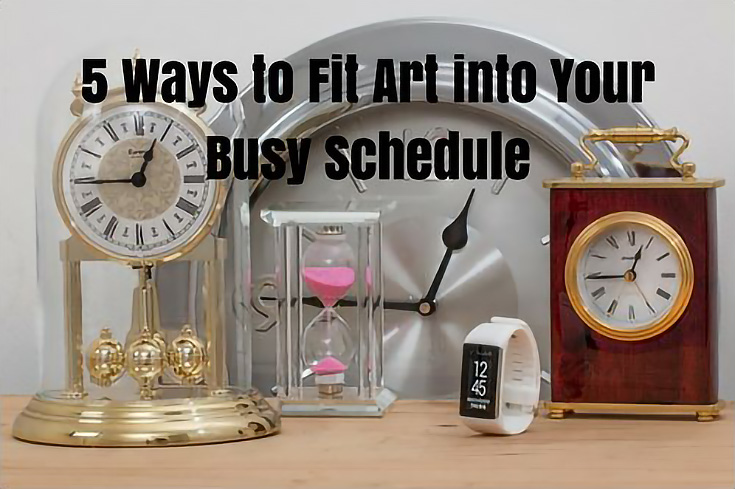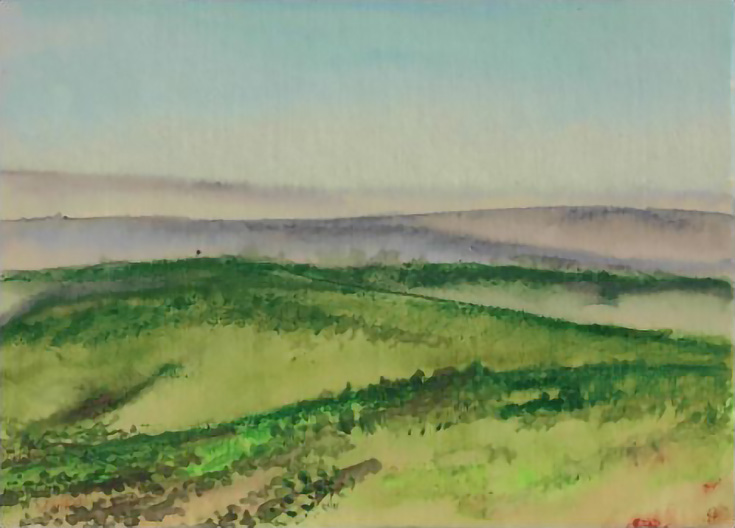We’re all busy these days. Work. Family. Community activities and other commitments. You don’t have to see a person’s daily planner to know they’re rushing from one thing to another. You have only to look out your window. Or at all the traffic with you on your commute.
And of course, artists are no different. We’re all looking for ways to fit art into an already busy schedule.

I’m no expert, but I have been an artist for as long as I can remember. I spent most of those 40-plus years with a full-time job, and all of them as a family member with obligations in and out of the home. Sometimes those obligations have been so overwhelming there’s been little or no time for art.
So I know a thing or two about fitting art in where it doesn’t seem possible. Here are five ways that have helped me:
1. Recognize the seasons of life
This may not seem at first glance to fit the topic for this article, but it does in at least one way. it takes the pressure off when you just can’t make art for reasons beyond your control.
Three years ago this spring, I spent five days in the hospital with injuries to both hands. The injuries led to cellulitis, and after that, low-level rehabilitation. For nearly a month, I could barely hold a pencil, let alone paint or draw. There was simply nothing I could do about it.
There may be a time when you’re simply not able to make art. Be it illness, major life changes (marriages, births, deaths, moves) or other situations, something will happen that will keep you from creating art. Perhaps for an extended period.
The best thing you can do is recognize those times and meet them head on. It does no good to fret, complain, or deny them. Those activities will only add stress to an already stressful situation, and heap guilt over not making art on top of everything else.
Realize that the situation is temporary. Then take care of what needs taken care of, and let your creative side rest and rejuvenate. Use it for reading about art, learning about new things, and perhaps planning.
I speak from personal experience when I say the time will not be wasted. And when the situation ends, you’ll be ready to get back to work.
2. Make use of “idle” time
Even in the best of times, we all have time that seems to be used up, but that can be converted to art time if we’re creative about it. All you need to do is keep some drawing materials with you, and any time can be art time.
Lunch is a great time to draw from life, whether it’s inside the break room, in your car, or in a nearby park or diner. Rest your mind as well as your body by turning your simple lunch break into an art-and-eat break.
On hold with a long-distance telephone call? Do some doodling. Hey, it’s art isn’t it? That’s the goal, isn’t it? Making art? Don’t discount those doodles because you never know where they may lead.
Waiting at a doctor’s office? Take out a scrap of paper and start sketching.
Or, just take out your sketchbook at the end of every day to wind down and relax.
Everyone’s schedule looks different (other than being jam-packed, of course.) Look for those times when you’re not actively engaged in something else, but when you could do art.
3. Turn off the TV
Sometimes fitting art into a busy schedule is more about decision-making than finding time. Sometimes you just have make time, and the best way I know to do that is to give up something that makes poor use of time and replace it with something more creative.
We have a television in our living room, but it hasn’t been used since before high definition. We watch no television, choosing instead to use most weekday evenings for business. Evenings are one of my best creative times, now.
But you don’t have to go cold turkey!
Swap one weekly program for an equal amount of art time and you’ll be surprised how much art you can make. You may even find you don’t miss the television at all.
4. Take time to play
Sometimes the only thing you have time for is playing. As in testing a new medium or new tools, or trying old, familiar tools on new surfaces.
That’s what I did with the small piece below. I didn’t have a lot of time to give to art on this particular day, and I didn’t have much motivation to make time. But I wanted to know how watercolor pencils perform on sanded paper badly enough to do a little playing.
Answer? Surprisingly well.
The piece took half an hour or less, including drying time. No, it’s not a masterpiece. Nor is it anywhere near my standard goals for landscape paintings. But I learned something new. And I had one more painting afterward than I had before picking up brush and pencil.
5. Keep an art journal
Art journals come in a variety of shapes and sizes. Some are for dry media, and some are for wet. Find one that suits your life-style and artistic nature, pair it with a few basic drawing or painting tools, and you’re all set.
Ideally, it should be small enough to carry with you wherever you go, in a purse, backpack or briefcase. A nice dedicated field kit is also a good option, especially if you already like to draw outside or would like to start that habit.
For even the serious artist, fitting art creation into a busy schedule can be a challenge.
But I know it’s a challenge that can be overcome. And even if these five suggestions don’t work for you, I hope they open your eyes to other opportunities that might be waiting patiently, somwhere in your busy schedule.
This post may contain affiliate links.


